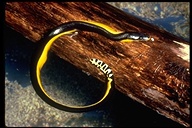It’s Alive! Yellow-Bellied Sea Snake in New Zealand
Posted by: Loren Coleman on April 27th, 2008

The Yellowbelly Sea Snake or Pelagic Sea Snake (Pelamis platurus) is a species of sea snake found in tropical oceanic waters around the world.
It occurs on both sides of the Pacific and is the only sea snake to have reached the Hawaiian Islands. It is so widespread that even one dead specimen has been found in Russia, on the coast of the Sea of Japan, near Vladivostok city.

One of the world’s most poisonous snakes has now caused a stir in New Zealand, making its way to the snake-free country.
When the 90-centimetre yellow-bellied sea snake washed up at Dargaville, north of Auckland, locals rushed to the beach.
Police had to cordon off the area and stand guard.
Experts believe the snake caught a ride in currents, possibly from Tonga.
It is now recovering at an Auckland marine centre where Andrew Christie is the curator.
“We get three or four sightings a year, but usually when they come to shore they are dead or at death’s door,” he said.
Few sea snakes survive in New Zealand’s cold waters.
The yellow-bellied sea snake is part of the cobra family.
Sources: Background research and “Snake-free NZ gets yellow-bellied surprise” by Kerri Ritchie, Australian Broadcasting Corporation, 24/4/08.
About Loren Coleman
Loren Coleman is one of the world’s leading cryptozoologists, some say “the” leading living cryptozoologist. Certainly, he is acknowledged as the current living American researcher and writer who has most popularized cryptozoology in the late 20th and early 21st centuries.
Starting his fieldwork and investigations in 1960, after traveling and trekking extensively in pursuit of cryptozoological mysteries, Coleman began writing to share his experiences in 1969. An honorary member of Ivan T. Sanderson’s Society for the Investigation of the Unexplained in the 1970s, Coleman has been bestowed with similar honorary memberships of the North Idaho College Cryptozoology Club in 1983, and in subsequent years, that of the British Columbia Scientific Cryptozoology Club, CryptoSafari International, and other international organizations. He was also a Life Member and Benefactor of the International Society of Cryptozoology (now-defunct).
Loren Coleman’s daily blog, as a member of the Cryptomundo Team, served as an ongoing avenue of communication for the ever-growing body of cryptozoo news from 2005 through 2013. He returned as an infrequent contributor beginning Halloween week of 2015.
Coleman is the founder in 2003, and current director of the International Cryptozoology Museum in Portland, Maine.










another fascinating posting, loren! i gained so much more information from your review than reading several different articles online as well as reviewing CNN’s video footage, the latter of which offered no background information at all!
i now at least understand why the fuss: the climate has prevented formerly lucky New Zealanders from becoming a poisonous sea snake haven, which as at least one (formerly ignorant) type like myself would presume it already was given its island status!
QUOTE: “Few sea snakes survive in New Zealand’s cold waters.”
Could the increase in these sitings of these snakes, including this live one, be an effect related to increases in average sea temperature (as a result of global warming)?
I do not like snakes but that critter is beautiful!
New Zealand has no snakes hmmmm ….if it only had bigfoot it would be perfect. 🙂
It is indeed beautiful…
And dangerous…
I did not know NEW ZEALAND had no snakes!!!
Fascinating…
It just occurred to me…
Maybe ST PATRICK visited NZ before going to Ireland???
Heh-heh-heh.
Good posting as usual, Loren!!!
Point Radix, I suppose it is a possibility, hopefully someone would have a look at it.
Yeah, I’m not the greatest fan of snakes, but that animal has a beautiful color.
I’ll put my hand up for the snakes… snakes are gorgeous! 🙂
I went on holiday there for a month a few years back and was amazed to learn that there aren’t any natural land-based predators on the 2 islands.
Now Opossums, they aren’t native and have endangered several species of birds. So everywhere you go, you learn the #1 Kiwi rule.
Kill any Opossum you see.
Introduced mammals have had significant impacts on the indigenous fauna of New Zealand, especially the effects of domestic cats and dogs on several of the species of non-flying birds. However, I doubt that the rule of “killing opossums on sight” would find such ready acceptance in the case of people’s pets.
One interesting dimension of this snake issue is – can the arrival (and survival) of such snake species by “natural” means be viewed in the same way as species be viewed in the same ways as animals introduced by humans? While the arrival and dispersal of snakes (poisonous or other) would undoubtedly have effects on the remaining native fauna, it must be remembered that almost all colonizations by plants and animals, on isolated islands is a result of these accidental or incidental arrivals.
From what I’ve read about seasnakes, although they are highly venomous, they are generally timid and will not bite unless provoked, and most times, not even then. I don’t know anything about this sub-species but my motto is, leave them alone and they’ll leave you alone.
It seems to me that the only danger from this snake would be to their natural prey and the other preditors whose habitats they might be invading.
Camperguy
is perfect we have the Moehau – The NZ version of Bigfoot and many more cryptids.
No to say there haven’t been trails at introductions – in the late 1800’s a sea captain tried to introduce the Australian Black Snake in the Zuckland area, nothing was ever seen or heard of them again, however in the 1950’s a black serpent was seen to cross a footpath in a park in Rotorua.
Tony Lucas
NZ Cryptozoologist